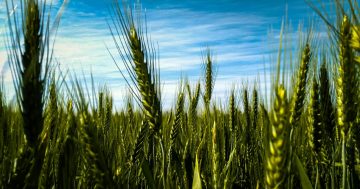
Wheat crops across the NSW South West Slopes are slowly ripening, but the wet weather has delayed the 2022 harvest by at least two weeks. Photo: Edwina Mason.
If there’s a region that might just tip the scales in terms of grain yields this year – the farmers in the western Riverina and down south near Berrigan might be gliding on golden grain all the way to the bank.
That news alone marks a massive shift from the more favoured regions such as Young, Wallendbeen, Cootamundra, and Harden who brandish the silver most years, but for their one perennial foe in 2022, the weather.
That’s not to say they won’t be in the mix; a few sunny weeks could mark the difference in a competition where paddocks offer prestige in the competitive world of farming.
So says Frank McRae – one of the state’s foremost agronomists and judge of the esteemed Suncorp Bank Championship Dryland Field competition, a 23-year-old event run by AgShows NSW, the peak body for 192 shows.
The word is that, uncharacteristically, farmers in NSW still have time to enter the annual state wheat competition as the La Nina-impacted harvest looms pushing entry cutoff dates out a further two weeks.
The northern region entries closed on October 26 – two weeks later than usual due to the rain – the flow-on effect means deadlines for western, southern and central regions have also been pushed back, allowing farmers time to assess their crops.

Scenes like these will litter the farming landscape throughout this year’s harvest as farmers battle the mud to pull off the harvest in saturated conditions. Photo: John Hayes.
Mr McRae will be back in the judge’s seat for the second year, assessing the top five crops in each region of the state.
He says there’s anything but dry land out there.
Due to above average autumn and spring rainfall, 2022 winter crop production in NSW has been variable with the forecast to fall short of the near-record production of last year.
“It’s been a challenging growing season with too much of a good thing in the way of rainfall and localised flooding on some growers’ land, but it’s certainly levelled the playing field,” Mr McRae said.
“The wet conditions delayed sowing in a lot of areas so the later sown crops may struggle yield-wise, particularly north of the Temora region which is very wet, but further south in well-drained country they’re looking at really top-yielding crops,” he added.
“The wheat competition is generally a yield-based competition, but if a grower has made the best of the local season with good management practices, they can expect a strong performance in this year’s competition”.
Mr McRae says that might make for a more exciting competition, but right now he is grappling with the logistics that judging, which kicks off next month, will present.
He hasn’t got a tinny to transport him from the flooded northern regions of NSW down to the NSW Victorian border, but he’d possibly take an airboat.
“I don’t know how I’m going to get on some of the crops,” he said. “Who would have thought we’d see such wet conditions after the worst drought in living memory?”
Same for the multitude of farmers who are all but polishing their stationary headers.
With each week still delivering massive falls of rain right across the state, there’s not much more they can do – leaving the machinery sheds for the quagmire beyond is too risky.
Then there’s the matter of being able to get the crop off with paddocks and overflowing springs the hidden danger in the dense, head high vegetation.
Despite this, competition organisers are still hoping to secure some high-quality entries from those who have successfully battled what the sky has thrown at them so far.
“Crop management and what growers have done in preparation stands out immediately, from rotations right through the year, to supporting soil health through nutrition, crop disease and whether they’ve applied fungicide – it’s a combination of all the management factors that come together,” Frank said.
“AgShows NSW Wheat Competitions provide a great learning opportunity for growers, and we’re certainly expecting to see some new entrants this year,” Mr McRae said.
The cutoff dates for competitions in each region are:
- Northern: 26 October
- Western: 9 November
- Central: 16 November
- Southern: 23 November
Judging kicks off next month, with northern growers first to submit their entries.
Central, southern, and western districts will follow to establish the top five crops in each region, before the regional, and finally, state winner is announced at the 2022 Wheat Presentation Dinner in Dubbo in January 2023.











